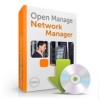Dell OpenManage Network Manager Web Client Guide 5.0 - Page 373
The Intra-Site Automatic Tunnel Addressing Protocol ISATAP is an IPv6 tran
 |
View all Dell OpenManage Network Manager manuals
Add to My Manuals
Save this manual to your list of manuals |
Page 373 highlights
FILE LOCATION: Q:\CD_Stage\Apps_CD\DellNM50\docs\OMNM_5\Glossary.fm FILTER - In network security, a filter is a program or section of code that is designed to examine each input or output request for certain qualifying criteria and then process or forward it accordingly. GUI - Graphical User Interface ISATAP - The Intra-Site Automatic Tunnel Addressing Protocol (ISATAP) is an IPv6 transition mechanism which is defined as a tunneling IPv6 interface and is meant to transmit IPv6 packets between dual-stack nodes on top of an IPv4 network. KEY - In cryptography, a key is a variable value that is applied using an algorithm to a string or block of unencrypted text to produce encrypted text. The length of the key generally determines how difficult it will be to decrypt the text in a given message. KEY MANAGEMENT - The establishment and enforcement of message encryption and authentication procedures, in order to provide privacy-enhanced mail (PEM) services for electronic mail transfer over the Internet. MANAGED OBJECT - A network device managed by the system. MEDIATION - Communication between this application and external systems or devices, for example, printers. Mediation services let this application treat these devices as objects. MEDIATION AGENT - Any communication to and from equipment is handled by the Mediation Agent. This communication includes SNMP requests, ASCII requests, and unsolicited ASCII messages. In addition, the Mediation Agent receives and translates emitted SNMP traps and converts them into events. MEG - Maintenance Entity Group MEP - Maintenance End Point MIB - Management Information Base. A database (repository) of equipment containing object characteristics and parameters that can be monitored by the network management system. OAM - Operation, Administration and Maintenance OID - Object ID. OSPF - Open Shortest Path First routing protocol. POLICY - A rule made up of conditions and actions and associated with a profile. Policy objects contain business rules for performing configuration changes in the network for controlling Quality of Service and Access to network resources. Policy can be extended to perform other configuration functions, including routing behavior, VLAN membership, and VPN security. POLICY ENFORCEMENT POINTS (PEP) - In a policy enforced network, a policy enforcement point represents a security appliance used to protect one or more endpoints. PEPs are also points for monitoring the health and status of a network. PEPs are generally members of a policy group. DELL CONFIDENTIAL - PRELIM INARY 5/23/12 - FOR PROOF ONLY Template Last Updated - 7/01/2005 | Glossary 373















